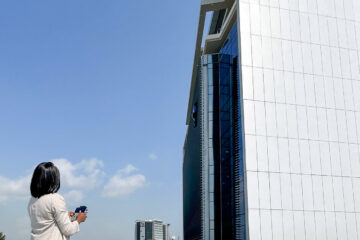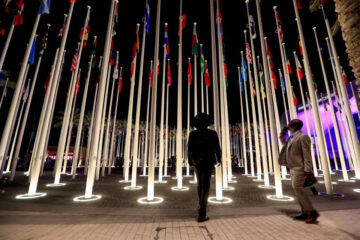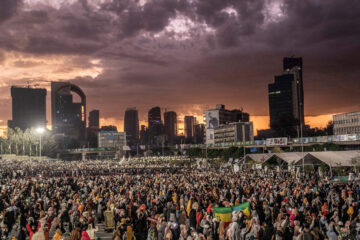WE live in tumultuous times. In the space of just a few years, we have witnessed a surge in populist politics across the world, a global pandemic, a spike in environmental disasters and a fraying of geopolitical relations demonstrated by the tragic war in Ukraine and escalating tensions over Taiwan.
That has all occurred against a backdrop of dramatic technological changes that are fundamentally altering the way we work and relate to one another.
Our future is in the balance. Cities will be central to our fate, for two reasons.

First, they are now home to over half of the global population, a share that will rise to two-thirds by 2050. That is something never before seen in human history and means that the forces shaping life in cities now also shape our world as a whole.
Second, cities throughout history have been the engines of human progress. Cities are where solutions are found – but also where perils are amplified when we fail to act.
This article draws on a book I co-authored with Tom Lee-Devlin, Age of the City: Why our Future will be Won or Lost Together, which has just been published by Bloomsbury. As the book’s subtitle highlights, we need to ensure that we create more inclusive and sustainable cities if all our societies are to thrive.
Cities as seats of populist revolt
The great paradox of modern globalisation is that declining friction in the movement of people, goods and information has made where you live more important than ever. Appreciation of the complexity of globalisation has come a long way since the early 2000s, when American political commentator Thomas Friedman’s The World is Flat and British academic Frances Cairncross’s The Death of Distance captured the public’s imagination.
We now know that, far from making the world flat, globalisation has made it spiky.
The growing concentration of wealth and power in major urban metropolises is toxifying our politics. The wave of populist politics engulfing many countries is often built on anger against cosmopolitan urban elites. This has been given expression through Brexit in Britain, and in support for anti-establishment politicians in the US, France, Italy, Sweden and other countries.
A common thread of all these populist movements is the notion that mainstream politicians, business leaders and media figures cocooned in big cities have let the rest of their countries down and lost interest in “left behind” places and people.
These populist revolts against dynamic cities are rooted in real grievances based on stagnating wages and soaring inequality.
A transformational effort to spread economic opportunity is long overdue. But undermining dynamic cities is not the way to do that. Cities like London, New York and Paris – and in the developing world Mumbai, Sao Paulo, Jakarta, Shanghai, Cairo, Johannesburg and Lagos – are engines of economic growth and job creation without which their respective national economies would be crippled.
What’s more, many of these cities continue to harbour profound inequalities of their own, driven by wildly unaffordable housing and broken education systems, among other things. They are also in a state of flux, thanks to the rise of remote working.
In places like San Francisco, offices and shops are suffering, municipal taxes are declining and businesses that depend on intense footfall – from barbers to buskers – are under threat. So too are public transport systems, many of which depend on mass commuting and are haemorrhaging cash.
All countries, therefore, are in dire need of a new urban agenda, grounded in an appreciation of the power of large cities – when designed properly – to not just drive economic activity and creativity, but also bring together people from many different walks of life, building social cohesion and combating loneliness.
But our focus must extend beyond the rich world. It is in developing countries where most of the growth in cities and the world’s population is taking place. Overcoming poverty, addressing the Sustainable Development Goals and addressing climate change, pandemics and other threats requires that we find solutions in cities around the world.
Dangers posed for cities in the developing world
Developing countries now account for most of the world’s city-dwellers, thanks to decades of dramatic urban growth.
In some cases, such as China, rapid urbanisation has been the result of a process of economic modernisation that has lifted large swathes of the population out of poverty.
In others, such as the Democratic Republic of Congo, urbanisation and economic development have been disconnected, with rural deprivation and the flight from danger playing a greater role in the migration to cities than urban opportunity.
Either way, cities are now where the world’s poor are choosing to live. And many of their cities are giant and overcrowded, with residents too often living in appalling conditions.
Appreciating what is happening in the cities of the developing world is essential if poverty is to be overcome. It also is vital if we are to understand why contagious diseases are making a comeback. Modern pandemics, from HIV to COVID-19, have their origins in these cities.
Crowded conditions are coinciding with a number of other trends in poor countries, including rapid deforestation, intensive livestock farming and the consumption of bushmeat, to increase the risk of diseases transferring from animals to humans and gaining a foothold in the population.
From there, connectivity between the world’s cities, particularly via airports, makes them a catalyst for the global dissemination of deadly diseases. That means that dreadful living conditions in many developing world cities are not only a pressing humanitarian and development issue but also a matter of global public health.
Tremendous progress has been made in the past two centuries in combating infectious diseases, but the tide is turning against us. Cities will be the principal battleground for the fight ahead.
Cities are also where humanity’s battle against climate change will be won or lost. Ocean rise, depletion of vital water resources and urban heatwaves risk making many cities uninhabitable. Coastal cities, which account for nearly all global urban growth, are particularly vulnerable.
While rich cities such as Miami, Dubai and Amsterdam are threatened, developing world cities such as Mumbai, Jakarta and Lagos are even more vulnerable due to the cost of developing sea walls, drainage systems and other protective measures.
At the same time, cities, which account for 70% of global emissions, will be at the heart of efforts to mitigate climate change. From encouraging public transport use and the adoption of electric vehicles to developing better systems for heating and waste management, there is much they need to do.
In 1987, Margaret Thatcher is reported to have declared: “There is no such thing as society”, only “individual men and women and families”. In fact, Homo sapiens is a social creature, and our collective prosperity depends on the strength of the bonds between us. If we are to survive the turmoil that lies ahead, we must rediscover our ability to act together. Since their emergence five millennia ago, cities have been central to that. We cannot afford to let them fail.
Ian Goldin and Tom Lee-Devlin, Age of the City: Why our Future will be Won or Lost Together, Bloomsbury, June 2023.














